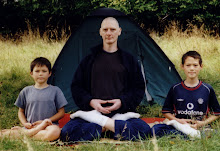Om. Manipadme! Hummmmmm.

Michael Thaler; March 23, 1962-January 15, 2008.
The photo was posted on Michael's blog One Foot in Front of the Other by Michael's sister, who took care of him in his final days.
Yesterday I emailed Professor Richard Gombrich, Academic Director of the Oxford Centre for Buddhist Studies and formerly Boden Professor of Sanskrit at Oxford University, to ask if he would kindly clarify for me the grammar of 'mani padme' in the mantra 'om mani padme hum.'
Professor Gombrich was kind enough to email straight back and say that it is probable, if it follows the pattern of many other mantras, that mani padme is a feminine vocative, addressing a goddess.
Last night, my sleep, or my dreams, were full of 'om mani padme hum.'
Then this morning, I found myself at the computer tapping out the following comment on One Foot in Front of the Other:
Hello Sister,
The padme in Om mani padme hum is said to be the female vocative form of padma, which means lotus, as in padmasana, the lotus posture. Mani means jewel. So manipadme is thought to be vocative form of “Jewel-Lotus,” who might be a female bodhisattva. (Bodhisattva = a being devoted to awakening as that of the Buddha.)
Who is the Jewel in the Lotus? She might be a wise midwife, a loving mother. Sometimes in Japan she is said to appear, in response to the cries of men in the world, as a gorgeous lover with a warm embrace. For the sick or dying, she might be a caring and compassionate nurse.
Om. Manipadme! Hum.
The opening syllable, 'om' or 'aum,' may be understood as beginning with the vowel sound 'a' -- the same vowel sound chosen by FM Alexander for his 'whispered ah' exercise, which is an exercise in non-doing, an exercise in openning.
The 'm' of 'om' and the 'm' of 'ma' come together in a hum -- mm, or mmmmm -- offering the opportunity to feel oneself resonating within. When we hum, if we are open within ourselves and the neck is lengthened so that the larynx is in relatively close proximity to the neck vertebrae, we can feel/hear the resonating cavities of the bony skeleton, resonating. There is what Paul Madaule calls "a bone-conducted audio-vocal feedback loop" from the larynx, through the skeleton, up to the bony casing of the inner ears. 'Mmmmm' offers us the opportunity to practice/experience this rapid bone-conducted loop from larynx to inner ear.
With the 'ma' of 'mani,' the challenge is to keep in touch with the bodily feeling of resonating, the kinaesthetic feel of one's voice -- 'mmmmm' -- while again projecting out the vowel sound 'aaaa,' the air-conducted sound of which one can hear resounding around the room, depending on the room's acoustics.
Paul Madaule, in an "Ear-Voice Connection" workshop I attended with him in Chester in 2001, encouraged us to play in the gap between two feedback loops -- the more immediate loop of inner, bone-conducted sound, and the secondary air-conducted loop which makes use of outer acoustics. Paul encouraged us to think of the bone-conducted sound as being like an orchestra and the air-conducted sound as being like a soloist. The game was to open up a gap between the soloist and the orchestra, in such a way that the soloist does not lose, does not get disconnected from, the orchesta.
The greater is the gap, the greater is the latitude to play -- to play, for example, with intention; or to consider the meaning of words.
'Mani' means jewel, a symbol of value.
'Padma' means lotus, a thing of beauty that grows out of mud, through water, and into light. To me the growth of the lotus symbolizes the kind of developmental work by means of which a human being may grow out of the purely instinctive behaviour exhibited by animals and by infants. Dropping off unconscious habits and conceptions, like a lotus emerging from muddy water, a person may be able to learn to perform an act like walking -- putting one foot in front of the other -- consciously. A person may be able to learn an act like sitting upright as a backward step of turning light and shining. Or a person may not be able to learn those things. A person may find in the end that those things, in their sheer and utter simplicity, are just too bloody difficult to learn. Thus a bloke of 48 years and 14 stones, after 26 years of sitting-zen and 15 years of Alexander work, may spit out his dummy in frustration and throw his toys out of the pram.
Anyway, the conjunction of mani and padme, to me, is suggestive of the real value that I know from experience that there can be in developmental work -- in the work, for example, of Paul Madaule.
Hum is the sound of closing, of drawing together, of integration.
Om mani padme hum.
Ommmmani padme hummmm.
Ommmmani padme hummmmmm.
Those sounds are good sounds for getting in touch with what Paul Madaule calls the ear-voice connection, through two feedback loops -- via bone conducted and air conducted sound.
There are some sites on the web in which it is argued that the mantra 'om mani padme him' is only sounds; that the mantra does not have meaning that can be translated into English. When I read that a few weeks ago, I immediately began to doubt it.
This morning when I wrote to Michael's sister, "Om. Manipadme! Hum", I bloody well meant it. On whose behalf I meant it, I do not know. But there was meaning in it.
Hummmmmm.


0 Comments:
Post a Comment
<< Home